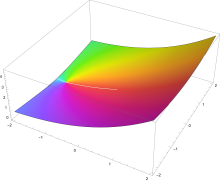
In mathematical analysis, the Bessel–Clifford function, named after Friedrich Bessel and William Kingdon Clifford, is an entire function of two complex variables that can be used to provide an alternative development of the theory of Bessel functions. If
is the entire function defined by means of the reciprocal gamma function, then the Bessel–Clifford function is defined by the series
The ratio of successive terms is z/k(n + k), which for all values of z and n tends to zero with increasing k. By the ratio test, this series converges absolutely for all z and n, and uniformly for all regions with bounded |z|, and hence the Bessel–Clifford function is an entire function of the two complex variables n and z.
Differential equation of the Bessel–Clifford function
It follows from the above series on differentiating with respect to x that satisfies the linear second-order homogeneous differential equation
This equation is of generalized hypergeometric type, and in fact the Bessel–Clifford function is up to a scaling factor a Pochhammer–Barnes hypergeometric function; we have
Unless n is a negative integer, in which case the right-hand side is undefined, the two definitions are essentially equivalent; the hypergeometric function being normalized so that its value at z = 0 is one.
Relation to Bessel functions
The Bessel function of the first kind can be defined in terms of the Bessel–Clifford function as
when n is not an integer. We can see from this that the Bessel function is not entire. Similarly, the modified Bessel function of the first kind can be defined as
The procedure can of course be reversed, so that we may define the Bessel–Clifford function as
but from this starting point we would then need to show was entire.
Recurrence relation
From the defining series, it follows immediately that
Using this, we may rewrite the differential equation for as
which defines the recurrence relationship for the Bessel–Clifford function. This is equivalent to a similar relation for 0F1. We have, as a special case of Gauss's continued fraction
It can be shown that this continued fraction converges in all cases.
The Bessel–Clifford function of the second kind
The Bessel–Clifford differential equation
has two linearly independent solutions. Since the origin is a regular singular point of the differential equation, and since is entire, the second solution must be singular at the origin.
If we set
which converges for , and analytically continue it, we obtain a second linearly independent solution to the differential equation.
The factor of 1/2 is inserted in order to make correspond to the Bessel functions of the second kind. We have
and
In terms of K, we have
Hence, just as the Bessel function and modified Bessel function of the first kind can both be expressed in terms of , those of the second kind can both be expressed in terms of .
Generating function
If we multiply the absolutely convergent series for exp(t) and exp(z/t) together, we get (when t is not zero) an absolutely convergent series for exp(t + z/t). Collecting terms in t, we find on comparison with the power series definition for that we have
This generating function can then be used to obtain further formulas, in particular we may use Cauchy's integral formula and obtain for integer n as
References
| This article includes a list of references, related reading, or external links, but its sources remain unclear because it lacks inline citations. Please help improve this article by introducing more precise citations. (August 2009) (Learn how and when to remove this message) |
- Clifford, William Kingdon (1882), "On Bessel's Functions", Mathematical Papers, London: 346–349.
- Greenhill, A. George (1919), "The Bessel–Clifford function, and its applications", Philosophical Magazine, Sixth Series: 501–528.
- Legendre, Adrien-Marie (1802), Éléments de Géometrie, Note IV, Paris.
- Schläfli, Ludwig (1868), "Sulla relazioni tra diversi integrali definiti che giovano ad esprimere la soluzione generale della equazzione di Riccati", Annali di Matematica Pura ed Applicata, 2 (I): 232–242.
- Watson, G. N. (1944), A Treatise on the Theory of Bessel Functions (Second ed.), Cambridge: Cambridge University Press.
- Wallisser, Rolf (2000), "On Lambert's proof of the irrationality of π", in Halter-Koch, Franz; Tichy, Robert F. (eds.), Algebraic Number Theory and Diophantine Analysis, Berlin: Walter de Gruyer, ISBN 3-11-016304-7.


 satisfies the
satisfies the 




 was entire.
was entire.





 , and analytically continue it, we obtain a second linearly independent solution to the differential equation.
, and analytically continue it, we obtain a second linearly independent solution to the differential equation.
 correspond to the Bessel functions of the second kind. We have
correspond to the Bessel functions of the second kind. We have



 that we have
that we have

